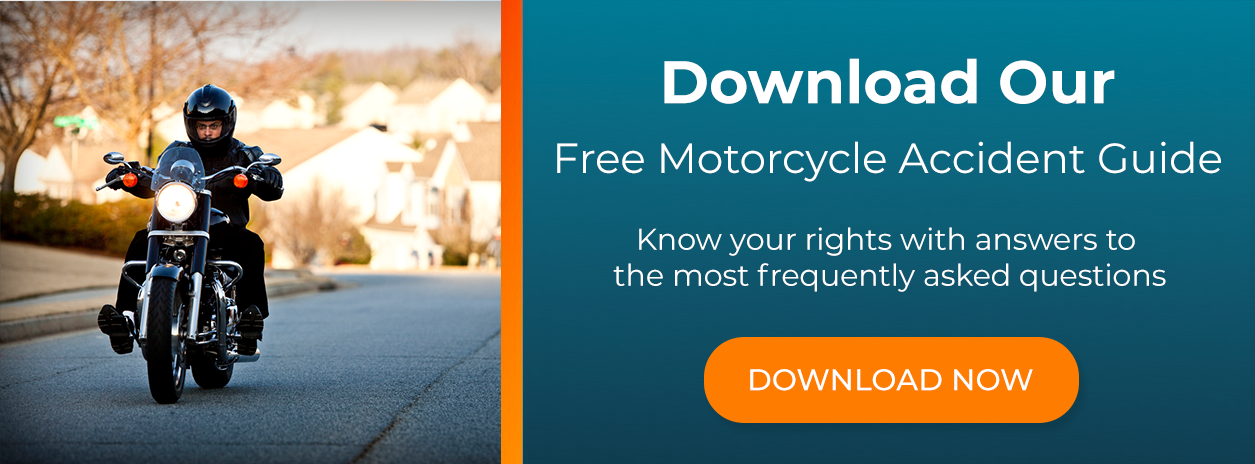Because of their relative lack of protection from injury, motorcyclists in Austin are among the most vulnerable drivers on the road. When crashes happen, as they inevitably do, the injuries can be severe — and sometimes fatal.
If you’re ever in a motorcycle accident, it’s important to know an experienced Austin motorcycle accident lawyer that you can call. We can help you pursue the maximum amount of compensation available for your various damages, and we also have the knowledge necessary to help guide you through each step of the legal process. Here’s what you need to know.
Free Consults24/7
Send Request NowWhat Causes Most Motorcycle Accidents in Austin?
Motorcycle accidents can be incredibly scary or catastrophic, as many people still fail to respect motorcyclists on the road as if they were driving a regular vehicle. The most common causes of motorcycle accidents are:
- Unexpected stops: Engaging in tailgating significantly contributes to accidents across all vehicle types. While minor collisions typically result in minimal damage for most vehicles, a rear-end motorcycle collision can lead to severe injuries, particularly if the impact is forceful enough to propel the rider off the bike.
- Excessive speed: Speeding is one of the primary catalysts for motorcycle accidents. Any vehicle traveling at high speeds significantly reduces the driver’s ability to detect and react to other vehicles, thereby increasing the likelihood of a collision.
- Left turns by cars: Collisions during left turns are prevalent among various vehicle types, but motorcycles, given their smaller size, face even greater visibility challenges when it comes to turning vehicles. Motorcyclists attempting to overtake cars within the same lane become even more susceptible to danger, as car drivers often fail to anticipate the presence of smaller vehicles like motorcycles before changing lanes.
- Lane splitting: Lane splitting or lane filtering refers to the act of a motorcyclist riding between two lanes, a practice deemed illegal in most states, including Texas, for good reason. Although motorcycles possess the agility to maneuver through traffic congestion by utilizing the space between lanes, a single misstep can jeopardize the life of a motorcyclist.
If you have been injured in a motorcycle accident, contact Zinda Law Group as soon as possible to speak to an Austin motorcycle accident attorney.
For a free legal consultation with a motorcycle accidents lawyer serving Austin, call 800-863-5312
Determining Fault in Austin Motorcycle Crashes
Several parties may be liable for your injuries following a motorcycle accident.
Another Driver
Similar to any car accident scenario, if the other driver involved in the collision was engaged in any of the following actions, it is highly likely that they bear partial or full responsibility for the accident:
- Driving while under the influence of alcohol or drugs
- Exceeding the speed limit
- Engaging in distracted driving
- Displaying reckless driving behavior
Manufacturer Liability
The motorcycle manufacturer can also be held accountable for an accident. For instance, if the brakes malfunctioned or a tire blew out, leading to a crash, the manufacturer may face liability.
City or Municipality
In certain cases, inadequate road maintenance may contribute to accidents. Issues such as potholes, limited visibility, uneven surfaces, or debris on the road can create hazards. The city or municipality responsible for road maintenance may be liable for accidents from poor road conditions.
Motorcycle Accident in Austin lawyers near me 800-863-5312
What Compensation Is Available to Injured Motorcyclists in Austin?
Typically, damages for personal injury claims fall under two categories: economic or non-economic damages.
Economic Damages
The primary categories of economic damages encompass medical expenses and lost wages. Medical expenses can encompass various aspects, such as:
- Costs associated with ambulance transportation
- Hospital fees
- Expenses for rehabilitation and physical therapy
- Potential future medical treatment costs
Lost wages account for the period during which you cannot work due to injuries sustained in the accident. Lost wages may include:
- Bonuses
- Overtime pay
- Vacation time
- Loss of earning capacity
You may also be entitled to compensation for vehicle repair or replacement expenses resulting from the accident. This may involve the cost of a rental car while your vehicle is being repaired.
Non-Economic Damages
Non-economic damages refer to losses or injuries experienced by the accident victim that do not have a monetary value attached to them. Non-economic damages can include:
- Pain and suffering
- Emotional distress
- Physical impairment
- Physical disfigurement
- Diminished quality of life
- Mental anguish
The damages you may be able to pursue will differ depending on your specific case. For more information, contact Zinda Law Group today.
Click to contact our Texas Motorcycle Accident Lawyer today
Injuries Often Sustained in Motorcycle Accidents
Injuries from a motorcycle accident may be severe and even life-threatening. Victims who survive these accidents may suffer debilitating injuries, including:
- Head injuries
- Road rash
- Nerve damage
- Bruising
- Internal bleeding
- Lacerations
- Broken bones
- Sprains
- Muscle injury
For more information on the injuries commonly sustained in motorcycle accidents, contact Zinda Law Group as soon as possible. Our team is here to help no matter how serious your injuries are.
Complete a Free Case Evaluation form now
Are Motorcycle Helmets Required by Law in Austin?
The Texas transportation code requires helmets to be worn by all individuals 20 years or younger. Helmets are also required for individuals 21 years or older unless they have successfully completed a motorcycle operator training and safety course or are covered by specific health insurance plans as provided under the law.
How Long do I Have to File a Motorcycle Injury Claim in Austin?
You will have two years to file a personal injury claim in Texas, including a motorcycle injury. This time limit is important to understand, as you may be barred from receiving compensation for your injuries if you fail to file in time.
Our Austin motorcycle crash lawyers have extensive experience filing motorcycle injury claims within the statute of limitations in Austin, and we can also help you. Contact our team as soon as possible to discuss how long you must file a personal injury claim.
Speak to an Austin Motorcycle Accident Lawyer Today
You may suffer from life-changing or severe injuries after being involved in a motorcycle accident. These injuries may cost you thousands of dollars in medical expenses, property damage, and other related fees. To receive compensation for these expenses, you may need the help of an Austin motorcycle accident attorney.
Our team of knowledgeable Austin personal injury attorneys at Zinda Law Group has extensive experience assisting victims who have suffered injuries from motorcycle accidents in seeking rightful compensation.
We operate under a contingency fee arrangement, which means you are not obligated to pay us anything unless we successfully win your case. That is our No Win, No Fee Guarantee. Call a Zinda Law Group personal injury attorney today to set up your free initial case evaluation.
Call or text 800-863-5312 or complete a Free Case Evaluation form



























